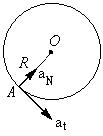Q. A particle is moving in a circle of radius $R$ in such a way that at any instant the tangential retardation of the particle and the normal acceleration of the particle are equal. If its speed at $t=0 \,$ is $\, v_{0}$ , the time taken to complete the first revolution is
NTA AbhyasNTA Abhyas 2022
Solution:
